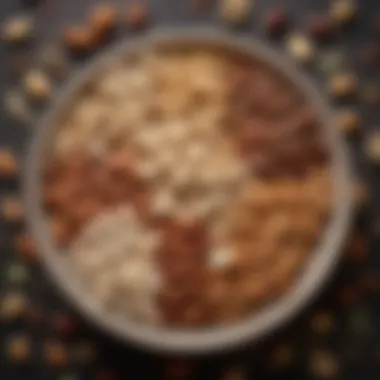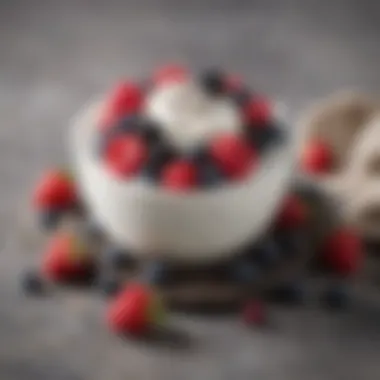Evening Snacks for Diabetics: A Comprehensive Guide


Intro
Evening snacks present a significant opportunity for individuals managing diabetes to maintain their blood sugar levels while enjoying flavors they love. Proper snacking can be an integral part of diabetes management, aiding in glycemic control and providing a balanced intake of nutrients. Choosing appropriate snacks requires an understanding of dietary needs and personal preferences. In this guide, we will explore various evening snack options that not only cater to diabetes but also enhance meal planning strategies. The importance of portion control and ingredient selection will be clarified, ensuring that snacks are supportive of a healthy lifestyle.
Recipe Overview
Recipe Name
Chickpea Salad with Avocado and Walnuts
Cuisine Type
Mediterranean
Ingredients
- 1 cup of canned chickpeas, rinsed and drained
- 1 ripe avocado, diced
- 1/2 cup of chopped walnuts
- 1 small red onion, finely chopped
- 1 cup of diced cucumber
- 1 cup of cherry tomatoes, halved
- Juice of 1 lemon
- 2 tablespoons of extra virgin olive oil
- Salt and pepper, to taste
- Fresh parsley or cilantro, for garnish
Substitutions for Common Ingredients
- Chickpeas: Can be substituted with black beans or lentils.
- Avocado: Greek yogurt can be used for creaminess.
- Walnuts: Pecans or sunflower seeds can work as alternatives.
- Red onion: Shallots or green onions can provide flavor as well.
Key Point: The use of wholesome ingredients like chickpeas and avocados ensures that the snacks are rich in fiber and healthy fats, which helps in managing blood sugar levels effectively.
When selecting ingredients, always consider their impact on blood sugar. Foods high in fiber tend to have a lower glycemic index, thus promoting better glycemic control. Meal planning should prioritize not just immediate hunger but also the longer-term effects on health. Integrating a variety of textures and flavors will make the snacking experience enjoyable. Whether for yourself, friends, or family, these snacks can be adjusted to meet individual tastes.
In the upcoming sections, we will analyze various snack options, discuss their health benefits, and offer further insights on effective meal planning.
Understanding Diabetes and its Dietary Needs
Diabetes is a chronic condition that affects how the body processes blood sugar, or glucose. It is crucial to understand the dietary needs of diabetics to maintain their health and manage their condition more effectively. Blood sugar levels can have a direct impact on many bodily functions. This makes it essential for individuals with diabetes to control their carbohydrate intake and choose foods that can help stabilize these levels. Moreover, understanding the nuances of diabetic nutrition aids in making informed choices that align with health goals.
The Importance of Blood Sugar Management
Blood sugar management is vital for preventing both short-term and long-term complications associated with diabetes. Elevated blood sugar can lead to serious problems such as heart disease, nerve damage, and kidney issues. Conversely, too low blood sugar can cause dizziness, confusion, and in extreme cases, loss of consciousness. Therefore, maintaining a balanced diet rich in appropriate carbohydrates, proteins, and healthy fats is essential. Regular monitoring of glucose levels also helps in understanding which foods impact these levels, enabling better meal planning and snack decisions.
Common Dietary Restrictions for Diabetics
Diabetics often face certain dietary constraints to manage their condition. Key restrictions typically include:
- Limiting refined sugars: Foods high in sugar can cause spikes in blood glucose, which should be avoided.
- Controlling carbohydrate intake: Carbohydrates increase blood sugar levels. Diabetics must be mindful of the types and amounts they consume.
- Choosing whole grains: Whole grain products generally have a lower glycemic index compared to refined grains, making them better choices for managing blood sugar.
- Mindful of portion sizes: Larger portions can lead to unintentional overconsumption of carbohydrates, affecting blood sugar levels.
Understanding these restrictions allows individuals to select appropriate foods that help them maintain stable blood sugar levels.
The Role of Snacks in a Diabetic Diet
Snacking can play a constructive role in a diabetic diet. Contrary to the common belief that snacking is detrimental to managing diabetes, healthy snacks can help maintain energy levels and prevent extreme blood sugar fluctuations between meals. Choosing snacks that are low in glycemic index, high in protein, and rich in fiber can support better blood sugar control. Moreover, incorporating snacks that fit into the overall dietary strategy can encourage consistency in managing diabetes.
As we explore various types of evening snacks and their benefits throughout this guide, remember that mindful eating contributes to overall well-being and better diabetes management. The key lies in understanding the balance of nutrients and making informed choices.
Nutritional Principles for Healthy Evening Snacks
When it comes to selecting evening snacks for diabetics, understanding nutritional principles is crucial. This consideration will help ensure snacks are not only satisfying but also contribute to maintaining blood sugar levels. Crafting snacks with a focus on nutritional balance reduces the risk of blood sugar spikes while providing essential nutrients. Here are the key nutritional elements to consider:
Balancing Carbohydrates and Proteins


Balancing carbohydrates with proteins is essential for a diabetic-friendly evening snack. Carbohydrates can elevate blood sugar levels, especially when consumed alone. Pairing carbs with proteins can slow digestion, promote gradual absorption, and ultimately stabilize blood sugar levels. Options like a handful of almonds with a small serving of fruit or Greek yogurt topped with berries serve this purpose effectively. The protein helps in managing hunger while supporting muscle health. Individuals should always measure portion sizes to avoid consuming excess.
Incorporating Healthy Fats
Incorporating healthy fats into evening snacks provides a satisfying, creamy texture while promoting cardiovascular health. Foods rich in omega-3 fatty acids, such as walnuts or chia seeds, can reduce inflammation and help manage diabetes. Healthy fats slow down the digestion of carbohydrates, aiding in blood sugar control. Items like avocado slices on whole-grain toast or a tablespoon of peanut butter with apple slices can be part of healthy evening snacks.
Utilizing Fiber for Satiety
Fiber plays a significant role in controlling hunger and maintaining satiety. High-fiber snacks are beneficial because they take longer to digest, which helps regulate blood sugar levels. Foods such as raw vegetables, legumes, or whole grains provide fiber. For instance, hummus served with carrot and cucumber sticks is both nutritious and filling.
By focusing on these principals, diabetics can enjoy their evening snacks without the worry of blood sugar fluctuations. Each component—carbohydrates, proteins, healthy fats, and fiber—contributes to a balanced approach. This planning encourages healthier habits and creates enjoyable eating experiences that comply with dietary needs.
Types of Evening Snacks for Diabetic Individuals
The selection of evening snacks is critical for people managing diabetes. An informed choice helps maintain blood sugar levels and contributes to overall health. This section will explore various categories of snacks that align with diabetic dietary needs while also being enjoyable.
Low Glycemic Index Options
Low glycemic index (GI) options are essential for diabetics. Foods with a low GI release glucose slowly into the bloodstream. This helps prevent spikes in blood sugar, offering better control. Examples include:
- Whole grains: Foods like quinoa and barley.
- Legumes: Lentils and beans are rich in fiber.
- Non-starchy vegetables: Such as broccoli and spinach.
Including these snacks can support stable energy levels throughout the evening. They also tend to be nutrient-dense, making them ideal for a well-rounded diet.
High-Protein Snacks
High-protein snacks are another beneficial category for diabetics. Adequate protein intake promotes satiety, helping to curb evening cravings. This can prevent excessive snacking and maintain balanced blood sugar. Good options include:
- Greek yogurt: Low in sugar and high in protein.
- Cottage cheese: Provides calcium and keeps you full.
- Hard-boiled eggs: Rich in protein and easy to prepare.
Selecting high-protein snacks encourages muscle health and can even aid in weight management.
Vegetable-Based Snacks
Vegetable-based snacks are crucial for providing vitamins and minerals while being low in calories and carbohydrates. They offer fiber, which is integral for digestive health. Suggested snacks could be:
- Raw carrot sticks with hummus.
- Cucumber slices drizzled with a little olive oil.
- Cherry tomatoes seasoned with herbs.
These snacks can also add a colorful touch to your plate, making them visually appealing and nutritious.
Nuts and Seeds as Snacks
Nuts and seeds are nutrient powerhouses loaded with healthy fats, protein, and fiber. These attributes make them an ideal choice for a diabetic snack. They help manage hunger and provide essential nutrients. Some good options include:
- Almonds: Rich in vitamin E and magnesium.
- Chia seeds: High in fiber and omega-3 fatty acids.
- Pumpkin seeds: Contain antioxidants and zinc.
While they are healthy, portion control is vital as they are calorie-dense. It’s wise to measure servings to avoid overindulgence.
Plant-Based Dairy Alternatives
Plant-based dairy alternatives have gained popularity as a snack option. These products, often lower in carbohydrates than traditional dairy, can be a great choice for individuals with lactose intolerance or those looking for lower-calorie options. Alternatives include:
- Almond milk yogurt: A lower sugar option with probiotics.
- Soy milk: A source of protein that can replace regular milk.
- Coconut yogurt: Creamy and full of flavor.
Choosing these products can also add variety to the diet. They can be used in smoothies or enjoyed on their own.


In summary, understanding the types of evening snacks suitable for diabetic individuals is paramount. It allows for a balanced approach to snacking that does not compromise health while still enjoying a range of flavors and textures.
Creative Recipes for Evening Snacks
The evening hours can often be challenging for people with diabetes. Finding snacks that satisfy cravings without compromising blood sugar levels is crucial. Creative recipes for evening snacks bridge this gap. They offer a variety of options that are not only nutritious but also delightful in taste. This section will present recipes that emphasize fresh ingredients, balance between macronutrients, and simplicity in preparation. Each recipe caters specifically to the dietary needs of diabetics, ensuring that enjoyment is not sacrificed.
Cucumber and Hummus Bites
Cucumber and hummus bites represent a perfect blend of refreshing and satisfying. Cucumber serves as a low-calorie base with high water content, offering hydration and a crispy texture. Hummus, made from chickpeas, provides good protein and fiber, promoting satiety. To create this snack, simply slice cucumbers into thick rounds and top them with a dollop of hummus. Consider adding a sprinkle of paprika or a few herbs for added flavor. This snack is not only easy to prepare but also rich in nutrients essential for managing blood sugar levels.
Chia Seed Pudding with Berries
Chia seed pudding is another excellent choice. Chia seeds are high in fiber and omega-3 fatty acids, contributing to heart health while helping to keep blood sugar stable. To make the pudding, combine chia seeds with almond milk and a touch of vanilla extract. Allow it to rest overnight in the refrigerator. When ready to serve, top it with a selection of berries, such as strawberries or blueberries, which are lower in sugar. This recipe is particularly beneficial because it can be prepared in advance, making it a convenient evening snack option.
Roasted Chickpeas with Spices
Roasted chickpeas are a crunchy snack that is simple to make. Chickpeas are rich in protein and fiber, which can help regulate blood sugar levels. To prepare them, rinse canned chickpeas, pat them dry, and toss them with olive oil and spices of your choice. Options like cumin, paprika, or garlic powder can add depth of flavor. Roast them in the oven until they are crispy. This snack provides not only satisfaction but also a healthy alternative to traditional chips.
Greek Yogurt with Nuts and Cinnamon
Greek yogurt offers a creamy snack option that is high in protein and probiotics. When selecting Greek yogurt, choose the plain variety with no added sugars. To enhance the flavor, mix in a handful of nuts such as almonds or walnuts, which provide healthy fats. A sprinkle of cinnamon can also add warmth and sweetness without affecting blood glucose levels significantly. This combination helps in keeping you full and satisfied while being mindful of dietary needs.
Stuffed Bell Peppers with Quinoa
Stuffed bell peppers filled with quinoa serve as a hearty and nutritious snack. Quinoa is a complete protein and contains essential amino acids, making it an excellent choice for a healthy diet. Cooked quinoa can be mixed with diced vegetables and spices, then stuffed into halved bell peppers. Bake until the peppers are tender. This recipe not only satisfies hunger but also offers a good balance of macronutrients, making it ideal for evening consumption.
Tip: Each of these snack options supports blood sugar management while satisfying taste preferences. It is important to choose snacks that align with overall dietary goals for diabetes management, ensuring both nutrition and enjoyment.
Planning and Portion Control
Planning and portion control are crucial elements in managing diabetes, particularly when it comes to evening snacks. By carefully selecting snacks and regulating portion sizes, diabetics can significantly influence their blood sugar levels and overall health. This section will delve into two key aspects: serving sizes for diabetic snacks and meal timing considerations.
Serving Sizes for Diabetic Snacks
Understanding serving sizes helps diabetics maintain better control over their carbohydrate intake. For individuals managing diabetes, appropriate serving sizes can prevent spikes in blood sugar. The American Diabetes Association recommends specific serving sizes based on carbohydrate counts. Here are some guidelines:
- Fruits: Choose fresh fruits over dried. A serving is typically one medium apple, banana, or orange, or half a cup of berries.
- Nuts: Keep portions to about one ounce, which is roughly a small handful. Opt for unsalted varieties.
- Vegetables: Non-starchy vegetables, such as carrots or bell peppers, can be consumed freely. A serving is usually one cup raw or half a cup cooked.
By being mindful of serving sizes, diabetics can enjoy their snacks without the risk of consuming excessive carbohydrates or calories.
Meal Timing Considerations
The timing of snacks can significantly affect blood sugar levels. Incorporating snacks at appropriate intervals throughout the day can help manage hunger and avoid large fluctuations in blood sugar. Many experts suggest having snacks three to four hours after meals. This schedule helps maintain steady energy levels and prevents overeating during the next meal.
- Assess being active: Consider physical activity levels, as being more active may warrant a light snack before exercising to maintain energy.
- Schedule regular times: Aim for consistency in snacking times to help regulate your body's insulin response.
Snack timing is not just about eating; it's about eating smartly. By pairing snacks with the right nutrients, you’ll aid in overall glucose control.
Ultimately, creating a plan that includes well-timed, appropriately sized snacks can play an essential role in diabetes management. It helps not only in blood sugar control but also in achieving and maintaining a healthy weight.
Grocery Shopping Tips for Diabetics
Grocery shopping can be a daunting task for individuals managing diabetes. It is essential to understand how to make informed choices that support health while still satisfying cravings. Knowing what to look for can drastically affect not just blood sugar levels but also overall well-being. This segment will delve into practical guidance on navigating the supermarket aisles, focusing on specific strategies that ensure you are making wise food selections.
Reading Food Labels Effectively


Food labels serve as guides for understanding the nutritional value of a product. For diabetics, paying attention to these labels is crucial.
- Check the Serving Size: Many products have misleading serving sizes. Always compare the serving size to how much you plan to eat.
- Monitor Total Carbohydrates: This is often the most critical number for diabetics. It includes sugars, starches, and fiber, which can influence blood sugar levels. Consider focusing on items with lower total carbs per serving.
- Glycemic Index: Some products may display their glycemic index. If available, choosing items with a lower glycemic index can be beneficial.
- Watch for Added Sugars: Underline added sugars in the ingredient list. Ingredients are listed in order, meaning the first few ingredients make up most of the product.
- Fats and Proteins: Evaluate the fats (aim for unsaturated types) and protein content within each serving. High protein can assist in maintaining satiety and may help regulate blood sugar levels.
By getting accustomed to reading food labels, you can make confident decisions while shopping.
Choosing Whole Foods Over Processed Options
Opting for whole foods may yield significant health advantages. Whole foods generally contain fewer ingredients, and they usually lack additives and preservatives found in processed varieties.
- Nutritional Value: Whole foods like fresh fruits, vegetables, whole grains, and lean proteins generally provide essential vitamins and minerals without excess sugar or unhealthy fats.
- Fiber Content: Unprocessed foods tend to be high in fiber, aiding in digestion and offering a slower release of sugars into the bloodstream.
- Avoiding Trans Fats: Processed foods often contain trans fats, which can increase the risk of heart disease—a concern for many with diabetes. Choosing whole foods minimizes this risk.
Ultimately, the choice of whole foods supports a balanced diet and is aligned with your overall health goals.
Tip: Always try to fill your cart with a colorful array of fresh produce. This approach can enhance flavor and nutrition in your meals.
By practicing these shopping strategies, you can better align your grocery choices with your health goals. This will not only ease the management of diabetes but also enrich your overall dining experience.
The Role of Hydration in Snack Time
Hydration plays a critical role in the overall health and well-being of diabetics. While food choices are essential, drink options are equally significant when managing diabetes. Staying hydrated can influence how the body processes glucose and feels during snack time. This section examines why hydration matters and suggests healthy beverage options that align with a diabetic diet.
Importance of Staying Hydrated
For individuals with diabetes, proper hydration is essential not only for overall health but also for maintaining stable blood sugar levels. Water can help in the regulation of blood sugar by assisting the kidneys in flushing out excess glucose through urine. Dehydration may lead to higher blood sugar levels, complicating diabetes management. Additionally, adequate fluid intake can help reduce hunger, which may lower the risk of over-snacking.
It is important to keep in mind that sometimes, feelings of hunger can actually be signs of dehydration. Instead of reaching for another snack, drinking a glass of water might satiate the need. This method can also aid in managing portion control, which is vital for diabetics.
Healthy Beverage Options
When it comes to selecting beverages, diabetics should prioritize options that are low in sugar and calories. Here are some healthy alternatives:
- Water: The best choice. It is calorie-free and effective in maintaining hydration.
- Herbal Teas: Options like peppermint or chamomile provide flavor without added sugars.
- Sparkling Water: Choose varieties without added sugars or artificial sweeteners for effervescence without the calories.
- Unsweetened Almond Milk: A creamy option that can be enjoyable both cold and warm, adding variety to snacks.
- Coconut Water: In moderation, it offers natural sugars and electrolytes but should be consumed sparingly due to its carb content.
Always check labels for hidden sugars in beverage options.
Each of these beverages not only contributes to hydration but can complement snacks while keeping the overall carbohydrate load in check. Ensuring sufficient hydration can create a more effective snack experience, helping to stabilize blood sugar levels and enhance feelings of fullness.
Common Mistakes to Avoid
When it comes to snacking in the context of diabetes management, certain missteps can unintentionally compromise the effort toward maintaining healthy blood sugar levels. Understanding these common mistakes is vital for anyone looking to enjoy their evening snacks without the worry of adverse effects. By being aware and avoiding these pitfalls, individuals can enhance their overall dietary strategy and still indulge in delicious options.
Ignoring Glycemic Load
Glycemic load is a crucial factor to consider when selecting snacks for a diabetic diet. It measures how much a food raises blood sugar levels, taking both the carbohydrate content and the glycemic index into account. One common mistake that people with diabetes make is to focus exclusively on the glycemic index. While a low GI score indicates a slower rise in blood sugar, it does not paint the whole picture. For example, a food can have a low GI but still be high in carbohydrates, leading to a higher glycemic load.
Benefits of Monitoring Glycemic Load:
- Better Control: Understanding glycemic load allows for more effective blood sugar management. Foods with a high glycemic load can spike blood sugar, while those with lower loads are generally safer.
- Enhanced Meal Planning: Knowing which foods to avoid can simplify meal preparations and snack selections, thereby improving compliance with dietary restrictions.
Overindulging in Snacks
Another frequent error is overindulging in snacks. Even healthy options can contribute to significant calorie intake and potential problems with blood sugar levels if consumed in excess. Portion control is key. Snacking is often viewed as an opportunity to indulge a bit, but for those managing diabetes, moderation is essential.
Considerations for Better Snacking Habits:
- Mindful Eating: Taking the time to enjoy snacks and paying attention to portion sizes can help curb overindulgence. Using smaller plates can visually trick the brain into feeling satisfied with less.
- Setting Limits: Establishing a clear limit on the number of snacks per day and the portions can help keep caloric intake in check.
"A small portion of well-planned snacks can support overall health, but mindless snacking can have negative consequences."
By avoiding these common mistakes, individuals with diabetes will not only maintain better blood sugar levels but also enhance their snacking experience. Paying attention to glycemic load and practicing portion control are simple yet effective strategies that can make a significant difference.















